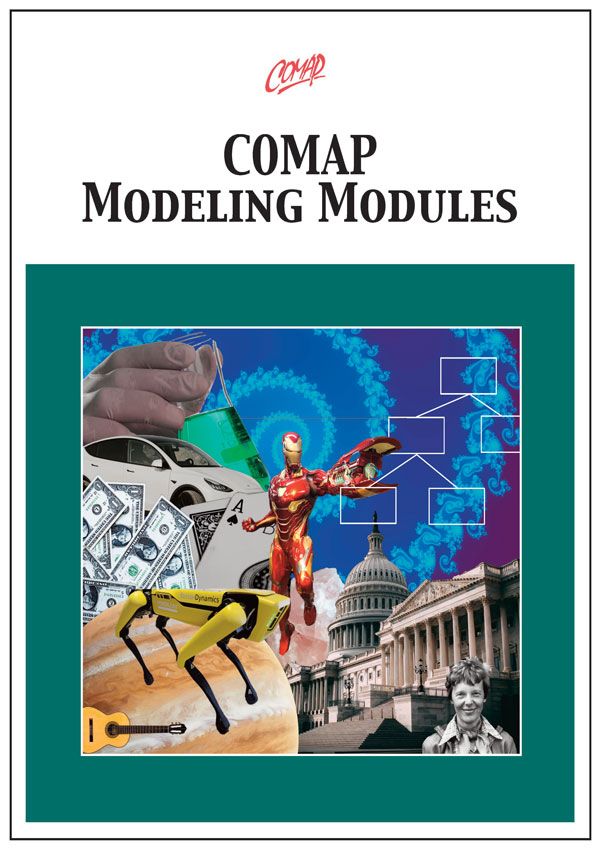Scene From Above: Modeling Environmental Changes (Modeling Module)
Author: Marsha Davis
The context for this module is estimating changes to the environment based on map and satellite images.
The module begins with a Preliminary Reading, Evaluating Earth’s Health, in which students view a world map showing the trend in annual leaf area based on satellite images. Students learn that urban expansion is partly to blame for one region where there is a decrease in annual leaf area. Urban expansion is also linked to dramatic events in the United States, such as the Los Angeles wildfires in 2025. The reading concludes with a discussion of how satellite images play a crucial role in both controlling the spread and modeling the behavior of wildfires. In the Preliminary Activity, A Bird’s Eye View, students are given a satellite image and a map showing the area around two schools. They select an item from the satellite image with a known dimension and use it to estimate the distance between the two schools. Next, they use the scale bar at the bottom of the satellite image to estimate the distance between the two schools. To compare their estimates, students must convert them to the same units.
Note: The information below was created with the assistance of AI.
Level of Mathematics
This article is best suited for middle to high school students (Grades 8–11), though it can also be extended into enrichment or competition-level math circles. The article’s accessible starting point allows younger students to engage, while the open-ended questions and generalizations challenge more advanced learners.
Key Skill Levels Involved:
-
Arithmetic operations (exponents, roots, factorials)
-
Number systems and representations
-
Basic modular arithmetic (implicitly)
-
Algebraic reasoning and function behavior
Application Areas
While theoretical in nature, the topic develops essential skills in:
-
Mathematical thinking and pattern recognition
-
Problem solving and generalization
-
Algorithmic thinking (how to form patterns with constraints)
-
Number theory foundations, applicable in:
-
Cryptography
-
Coding and algorithm design
-
Mathematical modeling
-
This type of problem also mimics the structure of puzzle-solving challenges often found in STEM competitions and math olympiads.
Prerequisites
To fully engage with the material, students should be comfortable with:
-
Basic operations:
-
Exponents and roots
-
Factorials and their notation
-
Arithmetic with integers and decimals
-
-
Patterns and sequences:
-
Recognition and abstraction
-
Logical reasoning
-
-
Symbolic reasoning:
-
Understanding expressions like √4 = 2 and 2² = 4
-
Manipulating numbers under transformation constraints
-
No advanced algebra or geometry is needed, making this a conceptual reasoning activity more than a computational one.
Subject Matter
The central focus is a numeric curiosity: writing a number using only a limited digit (specifically the digit 4), using a variety of operations (square roots, exponents, factorials, etc.).
Key Mathematical Concepts:
-
Numeric operations: Creating all digits 0–9 using only the digit 4 and operations
-
Exploration of constraints: e.g., using “four 4s” to create different numbers
-
Representation: Transforming digits creatively through operations
-
Generalization: Considering how many different digits are needed to express a set of numbers, or which digits are most “efficient”
The article encourages:
-
Open-ended exploration
-
Student-generated examples and conjectures
-
Progressive extensions: What if we use only three 4s? Or four 3s? Which digits are better?
These form the basis for rich classroom discussion and research-style inquiry.
Correlation to Mathematics Standards
Common Core State Standards (CCSSM):
-
6.EE.A.2: Write, read, and evaluate expressions in which letters stand for numbers
-
7.EE.B.3: Solve real-life and mathematical problems using numerical and algebraic expressions
-
8.EE.A.1-4: Understand and apply properties of integer exponents to generate equivalent expressions
-
HS.A-SSE.A.1: Interpret expressions that represent a quantity in terms of its context
NCTM Standards:
-
Problem Solving: Formulate, test, and refine conjectures
-
Connections: Link number patterns to broader mathematical structures
-
Reasoning and Proof: Develop and evaluate mathematical arguments
-
Representation: Use expressions and numeric symbols creatively
The content encourages alignment with mathematical modeling, abstraction, and exploration in line with modern curricular goals.

Mathematics Topics:
Application Areas:
Prerequisites:
You must have one of our Free Memberships or a paid Full Membership to download this resource.
If you're already a member, login here.